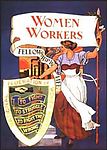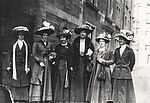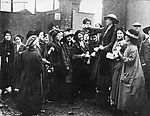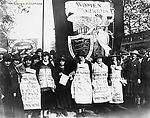 N.F.W.W. banner
N.F.W.W. banner N.F.W.W. organisers 1908. Mary Macarthur seated, Julia Varley on the left.
N.F.W.W. organisers 1908. Mary Macarthur seated, Julia Varley on the left. N.F.W.W. delegates to the Scottish Trade Union Congress. Mary Macarthur third from right.
N.F.W.W. delegates to the Scottish Trade Union Congress. Mary Macarthur third from right. Strike meeting at Morton's factory, Millwall
Strike meeting at Morton's factory, Millwall N.F.W.W. unemployment benefit demonstration 1920
N.F.W.W. unemployment benefit demonstration 1920

The failure of the Dundee jute workers dispute in 1906, because of the lack of funds to sustain them during a strike, highlighted the fact that small, scattered and impoverished groups of women were never going to generate enough money to maintain a union and build a strike fund. Mary saw the solution in making all these small organisations branches of a central body, comprising delegates from all the purely women's unions. The advantages would be a sense of solidarity, financial stability, benefits could be increased, and affiliation to the General Federation of Trade Unions would ensure strike pay. By the end of 1906 the National Federation of Women Workers (N.F.W.W.) was established with 2,000 members and seventeen branches in England and Scotland.
Throughout its history the N.F.W.W. had close ties with the Women's Trade Union League, of which Mary was secretary. Mary became the first President of the N.F.W.W., with Gertrude Tuckwell as secretary. They exchanged these roles in 1908. Three members of the League were elected onto the Federation's Executive Committee, and in all strikes the League provided an organiser to help the Federation. However, the Federation was very different from the League, which continued to function as a T.U.C. for unions with women members. It was a union rooted in the ideas and militancy of the early general labour unions. In its fight for better wages and conditions, it usually found that the strike was the only weapon at its disposal. Its record between 1906 and 1914 was largely one of strikes.
The story that Mary told of the Bundle of Sticks gives a simple outline of her trade union philosophy. "A Trade Union is like a bundle of sticks. The workers are bound together and have the strength of unity. No employer can do as he likes with them. They have the power of resistance. They can ask for an advance without fear. A worker who is not in a Union is like a single stick. She can easily be broken or bent to the will of her employer. She has not the power to resist a reduction in wages. If she is fined she must pay without complaint. She dare not ask for a 'rise'. If she does, she will be told, 'Your place is outside the gate; there are plenty to take your place.' An employer can do without one worker. He cannot do without all his workers. If all the workers united in a Union - strong as a bundle of sticks - complain or ask for improved conditions, the employer is bound to listen." (The Woman Worker, Autumn 1907)
In the years immediately following 1906, Mary and the Federation fought a battle on two fronts, the first to organise women into unions and encourage membership of the Federation, the second to campaign for legislation to fix minimum rates of pay for women working in the worst sweated trades. Sweating was characterised by earnings so low that they were barely sufficient to sustain existence, hours of labour so long that workers' lives were little more than ceaseless toil, and sanitary conditions at the workplaces so bad that they were not only injurious to their health, but also dangerous to the public.
Due in large part to the pressure exerted by Mary and the N.F.W.W. in 1909 a Trade Board was established for the chainmaking industry, which set a minimum wage. The success of the women chainmakers', who went out on strike in 1910 to ensure that the minimum wage was paid by all the chain employers, influenced the fixing of minimum wages in lace making, paper box making and wholesale and bespoke tailoring, without recourse to strike action. Five new Trade Boards were scheduled by the end of 1913. Between 1906 and 1914 N.F.W.W. membership increased from 2,000 to 20,000.
The success of the N.F.W.W. came under threat with the introduction of Lloyd George's National Health Insurance Act in 1911. Workers were required to pay 4d (2p) a week, the employer 3d (1.5p) and the state 2d (1p). Poorer workers could not afford to pay union dues and contributions to the National Insurance Scheme. Mary's solution was to form an Insurance section, which allowed any woman in an unorganised trade to join without having also to join the Union. Mary also influenced Lloyd George to amend his Bill by exempting women, whose daily wage did not exeed 1s 6d (7.5p). Other shortcomings were remedied in the Amending Act of 1913. Mary Macarthur and Margaret Bondfield were instrumental in getting maternity benefit included, which was made the property of the mother and was extended to include illegitimate children.
It was found that the number of women claiming sickness benefit under the Act was far greater than anticipated. There was criticism that it encouraged women to malinger. Mary, who knew the power of the press, and had used it to good effect in the past, launched a press campaign. She said, "The Act shows that people who are underfed, badly housed and overworked are seldom in a state of physical efficiency, and it has expressed in terms of pounds, shillings and pence the truth that where an industry pays starvation wages, it does in literal, sober fact levy a tax upon the community."
Mary's stand on women's suffrage was very practical. Her personal view was that all adults should have the vote, but she did not mix suffrage and trade unionism. The latter depended to a large extent on the goodwill and cooperation of men and women. There had already been a case where, in 1904, Derbyshire miners had refused to subscribe to the W.T.U.L. because they thought it supported women's suffrage.
Mary had always held the view that women and men should be in the same unions. Often a branch of the Federation was transferred to a men's union, which had decided to open its doors to women. When it was proposed that the Federation should merge with the National Union of General Workers (N.U.G.W.), Mary spoke in support. "We are convinced that inside the National Union we shall be able to demonstrate the possibility of a great industrial organisation of men and women, in which women are not submerged, but in which they take as active a part as men. That will be a great thing in the history of this country, for it has never been done before." (Sarah Boston, 1987)
By 325 votes to 13, the Federation voted to become a district of the N.U.G.W., later to become the National Union of General and Municipal Workers (N.U.G.M.W.). Unfortunately, Mary's hopes were not answered. The most militant union in the history of women's organisations, which had existed for just fourteen years, and organised more strikes than most unions with a longer history, became submerged in the National Union. Far from the voice of women gaining the backing of a large industrial organisation, by 1930 it had been so effectively silenced that the N.U.G.M.W. did not send one woman delegate to the T.U.C. conference that year.
Rollover the captions in the box to see the available images in thumbnail format, click the caption to see the full-size image
| Reference: | 714 |
| Keywords: | |
| Archive Ref: | |
| Updated: | Thu 12 Jul 2007 - 0 |
| Interpretation written by | Barbara Harris |
| Author's organisation | |
| Organisation's website |